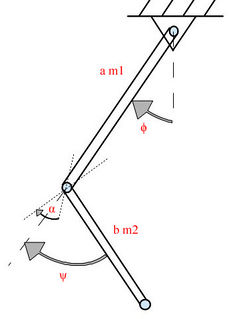Русская версия 
Specification of double pendulum oscillations
Rod is connected to the roof by cylindrical joint. The second rod is connected to the end of the first rod via cylindrical joint so that when both rods are vertical the angle between joint's axis equals to [math]\alpha[/math]. Dissipative forces are not taken to account.
System parameters:
- Inertia tensor of first and second rods are equal. [math]\underline{\underline{\Theta}}_1[/math] and [math]\underline{\underline{\Theta}}_2[/math] respectively.
- length of rods are a and b, their masses [math]m_1[/math] and [math]m_2[/math] for first and second rods.
- Angle between rotation axis of joints equals to [math]\alpha[/math]
- [math]\varphi[/math] - angle between first rod and vertical direction
- [math]\psi[/math] - angle between axis of first and second rods that means the angle in second joint relative to vertical orientation of system.
Main task:
- find the equation of motion for this double pendulum
Let's find the way of solving this problem: We are going to solve the problem by using the Lagrange equation:
[math]\frac{d}{dt}\frac{\partial T}{\partial \dot{q}_i}-\frac{\partial T}{\partial q_i} = -\frac{\partial \Pi}{\partial q_i}+Q_i[/math]
- [math]T[/math] - Kinetic energy of system
- [math]\Pi[/math] - Potential energy of system
- [math]q_i[/math] - Generalized coordinates
- [math]\dot{q}_i[/math] - generalized velocities
- [math]Q_i[/math] - generalized non-potential forces
Selecting generalized coordinates: for generalized coordinates we are going to use angles [math]\varphi[/math] and [math]\psi[/math]
- In this problem we neglect non-potential interactions, so generalized non-potential forces equals to zero.
Calculating potential and kinetic energy of system: [math]\Pi_1 , T_1 ; \Pi_2 , T_2 [/math] of first and second rods relatively.
[math]\Pi = \Pi_1 + \Pi_2[/math] - Potential energy of system
[math]T = T_1 + T_2[/math] - Kinetic energy of system
[math]T_1 = \frac{\underline{\omega}_1 \cdot \underline{\underline{\Theta}}_1 \cdot \underline{\omega}_1}{2} = \frac{\Theta_1 \omega_1^2}{2} = \frac{\Theta_1 \dot{\varphi}^2}{2}[/math] - Kinetic energy of first rod; Where
[math]\qquad \Theta_1 = \frac{m_1 a^2}{3}[/math] - Inertia torque of first rod
[math]\Pi_1 = m_1 g \left( \frac{a}{2} - \frac{a}{2} \cos \varphi \right)[/math] - Potential energy of first rod
[math]T_2 = \frac{\underline{\omega}_2 \cdot \underline{\underline{\Theta}}_2 \cdot \underline{\omega}_2}{2} + \frac{m_2 \vartheta_c^2}{2}[/math] - Kinetic energy of second rod
[math]\underline{\omega}_2 = ?[/math]
Finding second rod's angular velocity vector:
For calculating [math]\underline{\omega}_2[/math] we will find rotation tensors of both rods
[math]\underline{\underline{P}}_1(\varphi,\underline{k}) = \underline{k}\underline{k} + (\underline{\underline{E}} - \underline{k}\underline{k})cos(\varphi) + \underline{k} \times \underline{\underline{E}}sin(\varphi)[/math]
[math]\underline{\underline{P}}_2(\psi,\underline{e}) = \underline{e}\underline{e} + (\underline{\underline{E}} - \underline{e}\underline{e})cos(\psi) + \underline{e} \times \underline{\underline{E}}sin(\psi)[/math]
Where:
[math]\underline{e} = \underline{\underline {P}}_1 \cdot \underline{e}_0[/math] - second rod's ongoing rotation axis
[math]\underline{e}_0 = \cos(\alpha) \underline{k} + \sin(\alpha) \underline{i}[/math] - second rod's initial rotation axis
[math]\underline{\underline{P}} = \underline{\underline{P}}_2 \cdot \underline{\underline{P}}_1[/math] - full rotation tensor for second rod
But:
[math] \underline{\underline{P}} = \underline{\underline{P}}_2 \cdot \underline{\underline{P}}_1 = \underline{\underline{P}}(\psi,\underline{e}) \cdot \underline{\underline{P}}_1 = \underline{\underline{P}}_1 \cdot \underline{\underline{P}}(\psi,\underline{e_0})\cdot \underline{\underline{P}}^T_1 \cdot \underline{\underline{P}}_1 = \underline{\underline{P}}_1 \cdot \underline{\underline{P}}(\psi,\underline{e_0})[/math]
Now using the angular velocity addition formula we get:
[math]\underline{\omega}_2 = \underline{\omega}_1 + \underline{\underline{P}}_1 \cdot \underline{\tilde{\omega}}_2; \qquad \underline{\tilde{\omega}}_2 = \dot{\psi}\underline{e_0}[/math]
So we got the equation:
[math]\underline{\omega}_2 = \dot{\varphi} \underline{k} + \dot{\psi}\underline{e}[/math]
Finding second rod's center of mass velocity
[math]\underline{\vartheta}_c = \frac{1}{2}\underline{\omega}_2 \times \underline{b} + \dot{\varphi}\underline{k}\times \underline{a} ; \qquad \underline{a} = \underline{\underline{P}}_1 \cdot a\underline{j} ; \qquad \underline{b} = \underline{\underline{P}}_1 \cdot \underline{\underline{P}}(\psi,\underline{e_0}) \cdot b\underline{j}[/math]
Finding second rod's kinetic energy
Second rod's inertia tensor:
[math]\underline{\underline{\Theta}}_2 = \frac{ml^2}{12}\left(\underline{\underline{E}} - \underline{\tilde{e}\tilde{e}} \right) ;\qquad \underline{\tilde{e}} = \underline{\underline{P}}_1 \cdot \underline{\underline{P}}(\psi,\underline{e_0}) \cdot \underline{j}[/math]
Now we found all expressions required for second rod's kinetic energy formula:
[math]T_2 = \frac{\underline{\omega}_2 \cdot \underline{\underline{\Theta}}_2 \cdot \underline{\omega}_2}{2} + \frac{m_2 \vartheta_c^2}{2}[/math]
Finding second rod's potential energy
[math]\Pi_2 = mg(a+b - \underline{r}_c \cdot \underline{j}); \qquad \underline{r}_c = \underline{a} + \frac{1}{2}\underline{b}[/math] - radius-vector of second rod's center of mass
Finding the motion equation
We need to differentiate the equations for potential and kinetic energy, the way Lagrange equation requires and use the result in it. As the result we going to get the system of two differential equations which itself is equation of motion.
We notice that using this method we can get the motion equation also for big angles, it can be linearized assuming that angles [math]\varphi,\psi[/math] are small and dropping terms of second order.
Using this method for special case[править]
We'll check mentionad method for special case when [math]\alpha = 0[/math]
In this case problem becomes 2D.
Finding rotation tensors
[math]\underline{\underline{P}}_1(\varphi,\underline{k}) = \underline{k}\underline{k} + (\underline{\underline{E}} - \underline{k}\underline{k})cos(\varphi) + \underline{k} \times \underline{\underline{E}}sin(\varphi)[/math]
[math]\underline{e}_0 = \cos(\alpha) \underline{k} + \sin(\alpha) \underline{i} = \underline{k}[/math]
[math]\underline{e} = \underline{\underline {P}}_1 \cdot \underline{e}_0 = \underline{k}[/math]
[math]\underline{\underline{P}}_2(\psi,\underline{e})= \underline{\underline{P}}_2(\psi,\underline{k}) = \underline{k}\underline{k} + (\underline{\underline{E}} - \underline{k}\underline{k})cos(\psi) + \underline{k} \times \underline{\underline{E}}sin(\psi)[/math]
Finding second rod's angular vielocity
[math]\underline{\omega}_2 = (\dot{\varphi}+\dot{\psi})\underline{k}[/math]
Finding second rod's center of mass velocity
[math]\upsilon^2_c = \frac{1}{4} b^2 (\dot{\varphi}+\dot{\psi})^2 + ab\cos\psi(\dot{\varphi}+\dot{\psi})\dot{\varphi} + a^2\dot{\varphi}^2[/math]
Finding second rod's kinetic energy
[math]T_2 = \frac{1}{2} \left( \frac{m_2 b^2}{3}(\dot{\varphi}+\dot{\psi})^2 + m_2 ab\cos\psi(\dot{\varphi}+\dot{\psi})\dot{\varphi} + m_2 a^2\dot{\varphi}^2 \right)[/math]
Finding second rod's potential energy
[math]\Pi_2 = m_2 g \left[ a \left(1-\cos\varphi \right) + \frac{b}{2}\left(2 + \sin\varphi\sin\psi - \cos\varphi\cos\psi \right) \right][/math]
Finding first rod's kinetic and potential energy
[math]T_1 = \frac{1}{2}\frac{m_1 a^2}{3}\dot{\varphi}^2[/math]
[math]\Pi_1 = m_1 g \left( \frac{a}{2} - \frac{a}{2} \cos \varphi \right)[/math]
Finding equation of motion for this special case
Let's write equations for system's kinetic and potential energy:
[math]T = \frac{1}{2}\frac{m_1 a^2}{3}\dot{\varphi}^2 + \frac{1}{2} \left( \frac{m_2 b^2}{3}(\dot{\varphi}+\dot{\psi})^2 + m_2 ab\cos\psi(\dot{\varphi}+\dot{\psi})\dot{\varphi} + m_2 a^2\dot{\varphi}^2 \right)[/math]
[math]\Pi = m_1 g \left( \frac{a}{2} - \frac{a}{2} \cos \varphi \right) + m_2 g \left[ a \left(1-\cos\varphi \right) + \frac{b}{2}\left(2 + \sin\varphi\sin\psi - \cos\varphi\cos\psi \right) \right][/math]
Now we differentiate both equations and linearise results assuming that [math]\varphi , \psi[/math] are small and taking to account only infinitesimals of the first order. As the result we find equation of motion:
[math]
\begin{cases}
\ddot{\varphi} \left( \frac{m_1 a^2}{3} + \frac{m_2 b^2}{3} + m_2 a (a+b) \right) + \ddot{\psi} \left( \frac{m_2 b^2}{3} + \frac{m_2 ab}{2} \right) + \varphi \frac{g}{2} \left((m_1+2m_2)a+m_2 b \right)+\psi \frac{g}{2}m_2 b = 0\\
\ddot{\varphi} \left( \frac{m_2 b^2}{3} + \frac{m_2 ab}{2} \right) + \ddot{\psi} \frac{m_2 b^2}{3} + \varphi \frac{g}{2} m_2 b + \psi \frac{g}{2} m_2 b = 0\\
\end{cases}
[/math]
Discussing the results and conclusion[править]
The algorithm of solving the problem about double pendulum where both joints are cylindrical was described in this work. After that this method was used for special case of two-dimential problem.
Related links[править]
